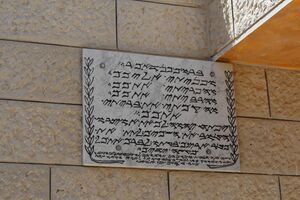العبرية السامرية
| Samaritan Hebrew | |
|---|---|
| ࠏࠁࠓࠉࠕ Îbrit | |
| المنطقة | إسرائيل وفلسطين، أساساً في نابلس وحولون |
| منقرضة | c. 2nd centurye18 survives in liturgical use |
| Samaritan script | |
| أكواد اللغات | |
| ISO 639-3 | smp |
| Glottolog | sama1313 |
| Linguasphere | 12-AAB |
Samaritan Hebrew (ࠏࠨࠁࠬࠓࠪࠉࠕ ʿÎbrit) is a reading tradition used liturgically by the Samaritans for reading the Ancient Hebrew language of the Samaritan Pentateuch, in contrast to Tiberian Hebrew among the Jewish people.
For the Samaritans, Ancient Hebrew ceased to be a spoken everyday language and was succeeded by Samaritan Aramaic, which itself ceased to be a spoken language some time between the 10th and 12th centuries and was succeeded by Arabic (or more specifically Samaritan Palestinian Arabic).
The phonology of Samaritan Hebrew is very similar to that of Samaritan Arabic, and is used by the Samaritans in prayer.[1] Today, the spoken vernacular among Samaritans is evenly split between Modern Israeli Hebrew and Palestinian Arabic, depending on whether they reside in Holon (Israel) or in Shechem (i.e. Nablus, in Palestine's Area A).
التاريخ والاكتشاف

The Samaritan language first became known in detail to the Western world with the publication of a manuscript of the Samaritan Pentateuch in 1631 by Jean Morin.[3] In 1616 the traveler Pietro della Valle had purchased a copy of the text in Damascus, and this manuscript, now known as Codex B, was deposited in a Parisian library.[4]
Between 1957 and 1977 Ze'ev Ben-Haim published in five volumes his monumental Hebrew work on the Hebrew and Aramaic traditions of the Samaritans. Ben-Haim, whose views prevail today, proved that modern Samaritan Hebrew is not very different from Second Temple Samaritan, which itself was a language shared with the other residents of the region before it was supplanted by Aramaic.[5]
Orthography

Samaritan Hebrew is written in the Samaritan alphabet, a direct descendant of the Paleo-Hebrew alphabet, which in turn is a variant of the earlier Proto-Sinaitic script.
The Samaritan alphabet is close to the script that appears on many Ancient Hebrew coins and inscriptions.[6] By contrast, all other varieties of Hebrew, as written by Jews, employ the later square Hebrew alphabet, which is in fact a variation of the Aramaic alphabet that Jews began using in the Babylonian captivity following the exile of the Kingdom of Judah in the 6th century BCE. During the 3rd century BCE, Jews began to use this stylized "square" form of the script used by the Achaemenid Empire for Imperial Aramaic, its chancellery script[7] while the Samaritans continued to use the Paleo-Hebrew alphabet, which evolved into the Samaritan alphabet.
In modern times, a cursive variant of the Samaritan alphabet is used in personal affects.
Letter pronunciation
Consonants
| Name | A'laf | Bit | Ga'man | Da'lat | Iy | Baa | Zen | It | Ṭit | Yut | Kaaf | La'bat | Mim | Nun | Sin'gaat | In | Fi | Tsaa'diy | Quf | Rish | Shan | Taaf |
| Samaritan Letter | ࠀ | ࠁ | ࠂ | ࠃ | ࠄ | ࠅ | ࠆ | ࠇ | ࠈ | ࠉ | ࠊ | ࠋ | ࠌ | ࠍ | ࠎ | ࠏ | ࠐ | ࠑ | ࠒ | ࠓ | ࠔ | ࠕ |
| Square Hebrew (Ktav Ashuri) letter | א | ב | ג | ד | ה | ו | ז | ח | ט | י | כ | ל | מ | נ | ס | ע | פ | צ | ק | ר | ש | ת |
| Pronunciation | [ʔ] | [b] | [ɡ] | [d] | [ʔ] | [b], [w] | [z] | [ʔ], [ʕ] | [tˤ] | [j] | [k] | [l] | [m] | [n] | [s] | [ʔ], [ʕ] | [f], [b] | [sˤ] | [q], [ʔ] | [r] | [ʃ] | [t] |
Vowels
| Niqqud with ࠌ/מ | ||||||
| value | /a/, /ɒ/ | /e/ | /e/, /i/ | /o/, /u/ | (geminate consonant) | /ʕa/ |
Phonology
Consonants
| Labial | Alveolar | Palatal | Velar~Uvular | Pharyn- geal |
Glottal | ||||
|---|---|---|---|---|---|---|---|---|---|
| plain | emp. | plain | emp. | ||||||
| Nasal | m | n | |||||||
| Stop | voiceless | t | tˤ | k | q | ʔ | |||
| voiced | b | d | ɡ | ||||||
| Fricative | voiceless | f | s | sˤ | ʃ | ||||
| voiced | z | ʕ | |||||||
| Approximant | l | j | w | ||||||
| Trill | r | ||||||||
Samaritan Hebrew shows the following consonantal differences from Biblical Hebrew: The original phonemes */b ɡ d k p t/ do not have spirantized allophones, though at least some did originally in Samaritan Hebrew (evidenced in the preposition "in" ב- /av/ or /b/). */p/ has shifted to /f/ (except occasionally */pː/ > /bː/). */w/ has shifted to /b/ everywhere except in the conjunction ו- 'and' where it is pronounced as /w/. */ɬ/ has merged with /ʃ/, unlike in all other contemporary Hebrew traditions in which it is pronounced /s/. The laryngeals /ʔ ħ h ʕ/ have become /ʔ/ or null everywhere, except before /a ɒ/ where */ħ ʕ/ sometimes become /ʕ/. /q/ is sometimes pronounced as [ʔ], though not in Pentateuch reading, as a result of influence from Samaritan Arabic.[9] /q/ may also be pronounced as [χ], but this occurs only rarely and in fluent reading.[9]
Vowels
| Front | Back | |
|---|---|---|
| Close | i iː | u uː |
| Mid | e eː | (o) |
| Open | a aː | ɒ ɒː |
| Reduced | (ə) | |
Phonemic length is contrastive, e.g. /rɒb/ רב 'great' vs. /rɒːb/ רחב 'wide'.[11] Long vowels are usually the result of the elision of guttural consonants.[11]
/i/ and /e/ are both realized as [ə] in closed post-tonic syllables, e.g. /bit/ בית 'house' /abbət/ הבית 'the house' /ɡer/ גר /aɡɡər/ הגר.[12] In other cases, stressed /i/ shifts to /e/ when that syllable is no longer stressed, e.g. /dabbirti/ דברתי but דברתמה /dabbertimma/.[12] /u/ and /o/ only contrast in open post-tonic syllables, e.g. ידו /jedu/ 'his hand' ידיו /jedo/ 'his hands', where /o/ stems from a contracted diphthong.[13] In other environments, /o/ appears in closed syllables and /u/ in open syllables, e.g. דור /dor/ דורות /durot/.[13]
Stress
Stress generally differs from other traditions, being found usually on the penultimate and sometimes on the ultimate.
Grammar
Pronouns
Personal
| singular | plural | ||
|---|---|---|---|
| 1st person | ࠀࠍࠊࠉ ā̊nā̊ki | ࠀࠍࠇࠍࠅ ā̊nā̊nnu | |
| 2nd person | male | ࠀࠕࠄ åttå | ࠀࠕࠌ attimma |
| female | ࠀࠕ(ࠉ) åtti (note the final yodh) | ࠀࠕࠍ attən | |
| 3rd person | male | ࠄࠅࠀ ū | ࠄࠌ imma |
| female | ࠄࠉࠀ ī | ࠄࠍࠄ inna | |
Demonstrative
| this | that | ||
|---|---|---|---|
| singular | masc | ࠆࠄ zē | alaz (written with a he at the beginning).[بحاجة لمصدر] |
| fem | ࠆࠀࠕ zē'ot | ||
| plural | ࠀࠋࠄ illa | ||
Relative
Who, which: éšar.
Interrogative
- Who? = ࠌࠉ mī.
- What? = ࠌࠄ mā̊.
Noun
When suffixes are added, ê and ô in the last syllable may become î and û: bôr (Judean bohr) "pit" > búrôt "pits". Note also af "anger" > éppa "her anger".
Segolates behave more or less as in other Hebrew varieties: beţen "stomach" > báţnek "your stomach", ke′seph "silver" > ke′sefánu (Judean Hebrew kaspe′nu) "our silver", dérek > dirkakimma "your (m. pl.) road" but áreş (in Judean Hebrew: 'e'rets) "earth" > árşak (Judean Hebrew 'arts-ekha) "your earth".
Article
The definite article is a- or e-, and causes gemination of the following consonant, unless it is a guttural; it is written with a he, but as usual, the h is silent. Thus, for example: énnar / ánnar = "the youth"; ellêm = "the meat"; a'émor = "the donkey".
Number
Regular plural suffixes are
- masc: -êm (Judean Hebrew -im)
- eyyamêm "the days"
- fem: -ôt (Judean Hebrew: -oth.)
- elamôt "dreams"
Dual is sometimes -ayem (Judean Hebrew: a′yim), šenatayem "two years", usually -êm like the plural yédêm "hands" (Judean Hebrew yadhayim.)
Tradition of the Divine Name
Samaritans have the tradition of either spelling out loud with the Samaritan letters
"Yohth, Ie', Baa, Ie' "
or saying "Shema" meaning "(The Divine) Name" in Aramaic, similar to Judean Hebrew "Ha-Shem" .
Verbs
| perfect | imperfect | ||||
|---|---|---|---|---|---|
| singular | plural | singular | plural | ||
| 1st person | -ti | -nu | e- | ne- | |
| 2nd person | male | -ta | -tímma | ti- | te- -un |
| female | -ti | -tên | ti- -i | te- -na | |
| 3nd person | male | - | -u | yi- | yi- -u |
| female | -a | ? | ti- | ti- -inna | |
Particles
Prepositions
"in, using", pronounced:
- b- before a vowel (or, therefore, a former guttural): b-érbi = "with a sword"; b-íštu "with his wife".
- ba- before a bilabial consonant: bá-bêt (Judean Hebrew: ba-ba′yith) "in a house", ba-mádbar "in a wilderness"
- ev- before other consonant: ev-lila "in a night", ev-dévar "with the thing".
- ba-/be- before the definite article ("the"): barrášet (Judean Hebrew: Bere'·shith') "in the beginning"; béyyôm "in the day".
"as, like", pronounced:
- ka without the article: ka-demútu "in his likeness"
- ke with the article: ké-yyôm "like the day".
"to" pronounced:
- l- before a vowel: l-ávi "to my father", l-évad "to the slave"
- el-, al- before a consonant: al-béni "to the children (of)"
- le- before l: le-léket "to go"
- l- before the article: lammúad "at the appointed time"; la-şé'on "to the flock"
"and" pronounced:
- w- before consonants: wal-Šárra "and to Sarah"
- u- before vowels: u-yeššeg "and he caught up".
Other prepositions:
- al: towards
- elfáni: before
- bêd-u: for him
- elqérôt: against
- balêd-i: except me
Conjunctions
- u: or
- em: if, when
- avel: but
Adverbs
- la: not
- kâ: also
- afu: also
- ín-ak: you are not
- ífa (ípa): where?
- méti: when
- fâ: here
- šémma: there
- mittét: under
References
- ^ Ben-Ḥayyim 2000, p. 29.
- ^ Frederic Madden, History of Jewish Coinage and of Money in the Old and New Testament, page ii
- ^ Exercitationes ecclesiasticae in utrumque Samaritanorum Pentateuchum, 1631
- ^ Flôrenṭîn 2005, p. 1.
- ^ Flôrenṭîn 2005, p. 4.
- ^ Herbermann, Charles, ed. (1913). . Catholic Encyclopedia. New York: Robert Appleton Company.
- ^ A History of the Hebrew Language. Cambridge, England: Cambridge University Press. 1993. ISBN 0-521-55634-1.
- ^ Ben-Ḥayyim 2000, pp. 31,37.
- ^ أ ب Ben-Ḥayyim 2000, p. 34–35
- ^ Ben-Ḥayyim 2000, pp. 43–44, 48.
- ^ أ ب Ben-Ḥayyim 2000, p. 47–48 (while Ben-Hayyim notates four degrees of vowel length, he concedes that only his "fourth degree" has phonemic value)
- ^ أ ب Ben-Ḥayyim 2000, p. 49
- ^ أ ب Ben-Ḥayyim 2000, p. 44, 48–49
Bibliography
- J. Rosenberg, Lehrbuch der samaritanischen Sprache und Literatur, A. Hartleben's Verlag: Wien, Pest, Leipzig.
- Ben-Ḥayyim, Ze'ev (2000). A Grammar of Samaritan Hebrew. Jerusalem: The Hebrew University Magnes Press. ISBN 1-57506-047-7.
- Flôrenṭîn, Moše (2005). Late Samaritan Hebrew: A Linguistic Analysis Of Its Different Types. BRILL. ISBN 9789004138414.
External links
 "[[s:Collier's New Encyclopedia (1921)/{{{1}}}|{{{1}}}]]". Collier's New Encyclopedia. 1921.
"[[s:Collier's New Encyclopedia (1921)/{{{1}}}|{{{1}}}]]". Collier's New Encyclopedia. 1921.- . Catholic Encyclopedia. 1913.
- Articles incorporating a citation from the 1913 Catholic Encyclopedia with Wikisource reference
- Short description is different from Wikidata
- المقالات needing additional references from July 2024
- كل المقالات needing additional references
- مقالات ذات عبارات بحاجة لمصادر
- Hebrew language
- Canaanite languages
- Language and mysticism
- Samaritan culture and history
- Languages extinct in the 2nd century



